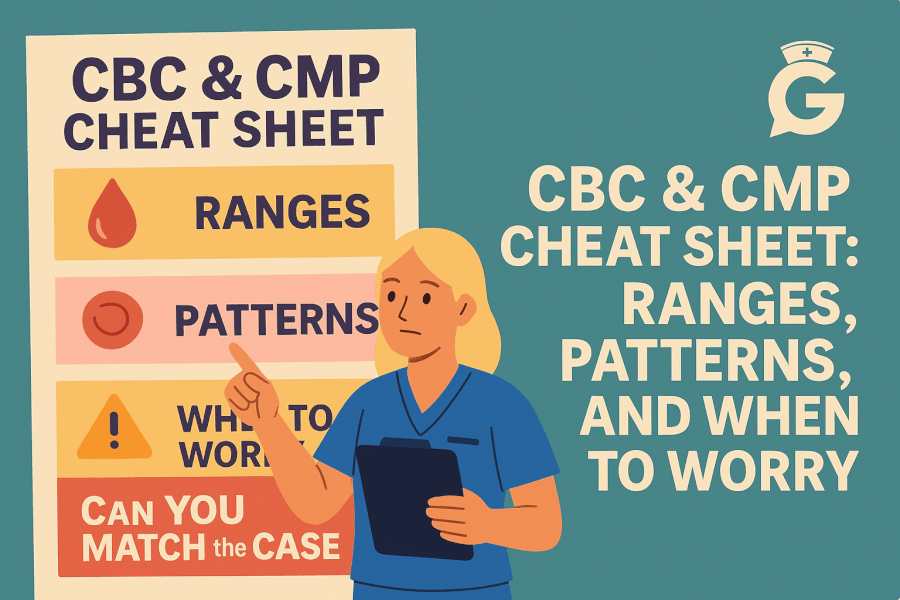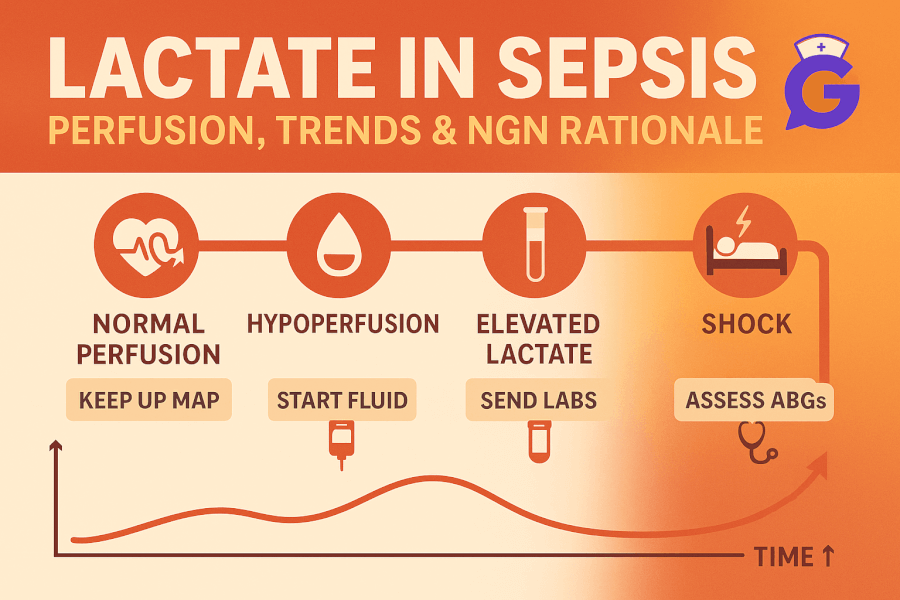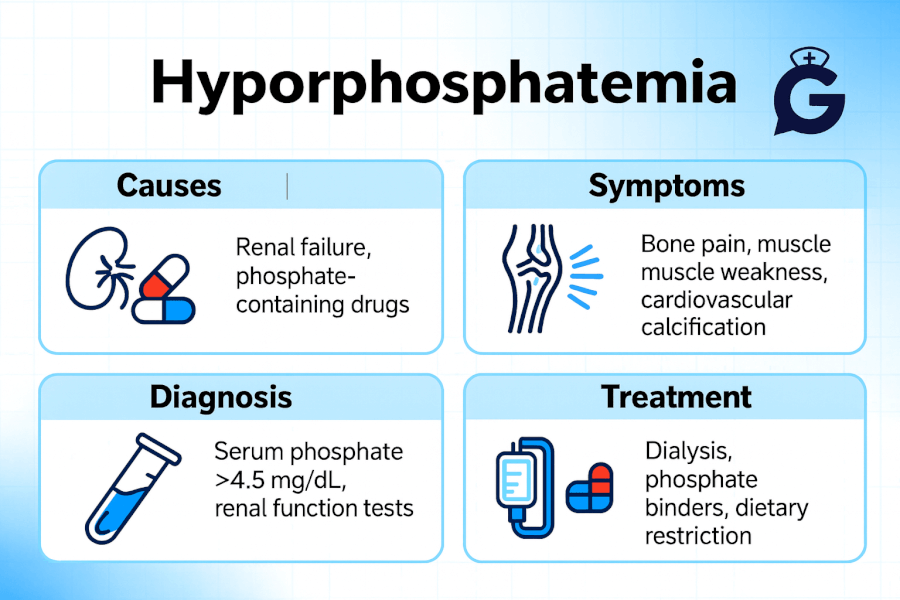You don’t need every number—you need the pattern that changes what you’ll do next. This cheat sheet distills the CBC and CMP into quick tables, fast interpretation cues, and nurse-priority actions. Use it before clinical, during practice questions, or when an NGN stem throws multiple labs at you at once.
If you want a broader list of ranges, keep Normal Lab Values (2025): Printable Cheat Sheet open while you read. For acid–base questions tied to CMP bicarbonate, pair this with ABG Interpretation Made Simple (2025). When stems feel crowded, review How to Read NGN Case Stems (2025) to reset your priority.
Table of Contents
- How to Use This Cheat Sheet
- CBC: Quick Ranges & What They Mean
- CBC Interpretation Patterns
- CMP: Quick Ranges & What They Mean
- CMP Interpretation Patterns
- When to Worry: Red Flags & First Actions
- NGN Tie-Ins: Action → Parameter Pairs
- FAQs
- Further Reading
🎯 Free NCLEX quiz!
Test your knowledge - new quizzes added weekly!
How to Use This Cheat Sheet
- Scan ranges to refresh anchors, but think in patterns—not isolated numbers.
- Name the single priority in one sentence, then choose two actions that change physiology.
- Pick two parameters you’ll reassess soon (10–30 minutes when appropriate) to prove the actions worked.
Note: Ranges vary by lab, assay, and population. Always compare with your facility’s or course’s reference ranges.
Professor’s note: If your first move is “order more tests,” you may be missing a fixable priority. Ask: “What can I do now that improves oxygenation, perfusion, or safety?”
CBC: Quick Ranges & What They Mean
| Test | Typical Adult Range* | What it tells you |
|---|---|---|
| WBC | 4.0–11.0 ×103/µL | Inflammation/infection; trend & differential matter |
| Hemoglobin (Hgb) | F: 12–16 g/dL; M: 13.5–17.5 g/dL | Oxygen-carrying capacity; bleeding vs dehydration |
| Hematocrit (Hct) | F: 36–46%; M: 41–53% | Proportion of RBCs; tracks with Hgb |
| RBC Count | F: 3.8–5.2; M: 4.3–5.7 ×106/µL | Quantity of red cells (interpret with indices) |
| MCV | 80–100 fL | Cell size: microcytic vs macrocytic anemia |
| MCHC | 32–36 g/dL | Hemoglobin concentration per RBC (hypo/hyperchromia) |
| RDW | 11–15% | Variation in RBC size; mixed deficiencies |
| Platelets | 150–400 ×103/µL | Clotting; low increases bleeding risk |
*Verify against your facility’s posted ranges.
Leukocyte differential (fast cues)
- Neutrophils ↑ (left shift): likely bacterial infection/inflammation.
- Lymphocytes ↑: often viral or chronic immune stimulation.
- Eosinophils ↑: allergy, asthma, parasites; some drug reactions.
- Bands ↑: acute infection/severe stressor.
CBC Interpretation Patterns
- Anemia pattern: ↓Hgb/↓Hct → assess bleeding, nutrition, chronic disease.
- Microcytic (low MCV): iron deficiency, chronic blood loss.
- Macrocytic (high MCV): B12/folate deficiency, alcohol, some meds.
- First actions: trend vitals, assess bleeding signs, consider stool/menstrual history; anticipate iron/B12/folate per orders.
- Hemoconcentration: ↑Hgb/↑Hct with dehydration signs → fluids as ordered; reassess MAP/UOP.
- Leukocytosis with left shift: suspect bacterial infection; check temp, source, cultures per protocol.
- Neutropenia: infection risk; protective precautions; monitor subtle sepsis signs.
- Thrombocytopenia: bleeding risk; review meds (heparin—HIT), petechiae/hematuria; avoid IM injections as appropriate.
🥇Voted #1 Nursing Study Tool.
Personalized AI Tutor + Instant Answers to All Your Questions. 100% Money Back Guarantee!
CMP: Quick Ranges & What They Mean
| Test | Typical Adult Range* | What it tells you |
|---|---|---|
| Sodium (Na⁺) | 135–145 mEq/L | Water balance, neurologic status |
| Potassium (K⁺) | 3.5–5.0 mEq/L | Cardiac conduction, muscle function |
| Chloride (Cl⁻) | 96–106 mEq/L | Acid–base partner to bicarbonate |
| CO₂ (HCO₃⁻) | 22–29 mEq/L | Metabolic component of acid–base (see ABG) |
| BUN | 7–20 mg/dL | Hydration/renal perfusion; ↑ with dehydration/catabolism |
| Creatinine | ~0.6–1.3 mg/dL | Renal filtration; compare to baseline/eGFR |
| Glucose (fasting) | 70–99 mg/dL | Metabolic control; context: therapy, steroids, sepsis |
| Calcium (total) | 8.6–10.2 mg/dL | Neuromuscular tone; correct for albumin |
| Total Protein | 6.0–8.3 g/dL | Nutrition, inflammation |
| Albumin | 3.5–5.0 g/dL | Oncotic pressure; chronic nutrition/liver status |
| ALP | ~40–129 U/L | Cholestasis, bone turnover |
| AST | ~10–40 U/L | Hepatocellular injury (also muscle) |
| ALT | ~7–56 U/L | More liver-specific than AST |
| Total Bilirubin | ~0.2–1.2 mg/dL | Hemolysis/cholestasis; jaundice patterns |
*Ranges vary by lab; verify locally.
Helpful formulas
- Corrected Ca²⁺ (mg/dL) ≈ measured Ca²⁺ + 0.8 × (4.0 − albumin).
- Anion Gap ≈ Na⁺ − (Cl⁻ + HCO₃⁻). Elevated gap → MUDPILES patterns (DKA, lactic acidosis, toxins, etc.).
CMP Interpretation Patterns
Sodium
- HypoNa⁺ with confusion/seizure → treat safely per protocol; avoid rapid correction; neuro checks.
- HyperNa⁺ with dehydration → fluid replacement guided by volume status; monitor mental status and sodium trend.
Potassium
- HyperK⁺ (≥6.0 or ECG changes): stabilize myocardium (e.g., calcium per protocol), shift K⁺ intracellularly (insulin + dextrose/β-agonist), remove K⁺ (diuretics/resins/dialysis as ordered). Continuous ECG; recheck K⁺.
- HypoK⁺: replace and monitor; evaluate Mg²⁺ (low Mg²⁺ makes K⁺ repletion harder).
Bicarbonate / Acid–Base
- Low HCO₃⁻: metabolic acidosis—think DKA, sepsis, renal failure; pair with ABG, lactate. Treat cause; trend gap/HCO₃⁻.
- High HCO₃⁻: metabolic alkalosis—vomiting/NG suction or diuretics; replace Cl⁻/K⁺; reassess symptoms and HCO₃⁻.
Renal
- Azotemia (↑BUN/Cr): pre-renal (hypoperfusion), intrinsic renal, or post-renal obstruction.
- Check UOP, volume status, nephrotoxic meds; adjust doses by eGFR; monitor MAP.
Liver (LFT patterns)
- AST/ALT >> ALP/bili: hepatocellular injury (viral, toxins, meds, ischemic).
- ALP + bili >> AST/ALT: cholestasis/obstruction (stones, tumor); evaluate RUQ pain, pruritus.
- Low albumin (chronic): nutrition/liver synthesis; influences corrected calcium and drug binding.
Calcium
- Low total Ca²⁺ with low albumin: may be pseudo-hypocalcemia—use corrected or ionized Ca²⁺.
- Symptomatic hypocalcemia: paresthesias, tetany—stabilize per protocol; replete cautiously and monitor ECG.
Professor’s note: Pair every action with the parameter that should budge first. Oxygen → SpO₂. Fluids → MAP/UOP. Insulin for DKA → anion gap and potassium trend.
When to Worry: Red Flags & First Actions
- WBC > 12k with fever or hypotension: consider sepsis; follow local sepsis bundle; reassess MAP, urine output, lactate trend.
- Hgb falling with hypotension, pallor, melena/hematemesis: suspect active bleed; large-bore IVs, fluids, type & screen per order; monitor MAP/UOP.
- Platelets < 100k with heparin exposure + new clot/pain: think HIT; stop heparin; alternative anticoagulation per order; monitor platelet trend and bleeding signs.
- Na⁺ acute drop with confusion/seizure: treat safely per protocol; avoid rapid overcorrection; neuro checks.
- K⁺ ≥ 6.0 or ECG changes: stabilize myocardium, shift K⁺ intracellularly, remove K⁺; continuous cardiac monitoring.
- Cr rising fast or eGFR falling with low UOP: review meds, hydrate per order, trend output; prevent further nephrotoxic exposures.
- ALT/AST into the hundreds/thousands or ALP/bili rising with RUQ pain/jaundice: notify provider, trend LFTs, evaluate obstruction/injury; monitor mental status and coags if severe.
Link these to realistic case practice: NGN Case Studies (2025): 25 Free Examples with Answers and Med-Surg / Physiological Adaptation Case Studies.
NGN Tie-Ins: Action → Parameter Pairs
- DKA (CMP: low HCO₃⁻, high glucose, K⁺ shifts)
Actions: fluids then insulin; Parameters: anion gap, glucose, potassium. - COPD exacerbation (CMP near-normal; ABG abnormal)
Actions: oxygen to target sats, bronchodilator; Parameters: SpO₂/WOB, PaCO₂ if monitored. - Acute bleed (CBC changes may lag early)
Actions: IV access and fluids/blood per order; Parameters: MAP, UOP, mentation. - Cholestasis pattern (ALP + bilirubin)
Actions: assess for obstruction pattern, symptom control; Parameters: bilirubin/ALP trend, pruritus relief. - Renal perfusion problem (↑BUN/Cr, low UOP)
Actions: fluids per protocol if pre-renal; review nephrotoxins; Parameters: UOP, Cr/eGFR, MAP.
For additional acid–base linkage, see ABG Interpretation Made Simple.
FAQs
Do I need to memorize every range?
Know anchors and patterns. Use this cheat sheet for ranges, then focus on what changes first and how you’ll measure it.
CBC looks normal but the client is unstable—what now?
Trends and the clinical picture come first. In active bleeding, vitals and assessment often lead labs. Treat the priority, then trend labs.
CMP bicarbonate is low—do I always have metabolic acidosis?
Often, yes—but confirm with ABG and the clinical story. Treat the cause (DKA, sepsis) and track the gap/HCO₃⁻.
How fast should I see improvements?
Some parameters move quickly (SpO₂, MAP, RR); others lag (Hgb/Hct after fluids, albumin). Pick parameters that show near-term change.







